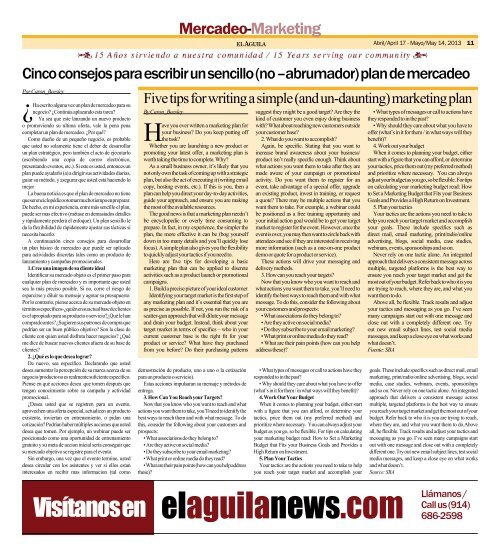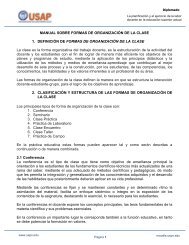abril-2013
Create successful ePaper yourself
Turn your PDF publications into a flip-book with our unique Google optimized e-Paper software.
Por Caron_Beesley<br />
¿Ha escrito alguna vez un plan de mercadeo para su<br />
negocio? ¿Continúa aplazando esta tarea?<br />
Ya sea que este lanzando un nuevo producto<br />
o promoviendo su ultima oferta, vale la pena pena<br />
completar un plan de mercadeo. ¿Por qué?<br />
Como dueño de un pequeño negocio, es probable<br />
que usted no solamente tiene el deber de desarrollar<br />
un plan estratégico, pero también el acto de ejecutarlo<br />
(escribiendo una copia de correo electrónico,<br />
presentando eventos, etc.). Si este es usted, entonces un<br />
plan puede ayudarlo (a) a dirigir sus actividades diarias,<br />
guiar su método, y asegurar que usted está haciendo lo<br />
mejor<br />
La buena noticia es que el plan de mercadeo no tiene<br />
que ser enciclopédico o tomar mucho tiempo en preparar.<br />
De hecho, en mi experiencia, entre más sencillo el plan,<br />
puede ser mas efectivo (métase en demasiados detalles<br />
y rápidamente perderá el enfoque). Un plan sencillo le<br />
da la flexibilidad de rápidamente ajustar sus tácticas si<br />
necesita hacerlo.<br />
A continuación cinco consejos para desarrollar<br />
un plan básico de mercadeo que puede ser aplicado<br />
para actividades discretas tales como un producto de<br />
lanzamiento y campañas promocionales.<br />
1.Cree una imagen de su cliente ideal<br />
Identificar su mercado objeto es el primer paso para<br />
cualquier plan de mercadeo y es importante que usted<br />
sea lo más preciso posible. Si no, corre el riesgo de<br />
esparcirse y diluir su mensaje y agotar su presupuesto.<br />
Por lo contrario, piense acerca de su mercado objeto en<br />
términos específicos-¿quién en su actual base de clientes<br />
es el apropiado para su producto o servicio?¿Qué le han<br />
comprado antes? ¿Sugieren sus patrones de compra que<br />
podrían ser un buen público objetivo? Son la clase de<br />
cliente con quien usted disfruta hacer negocios? ¿Qué<br />
me dice de buscar nuevos clientes afuera de su base de<br />
clientes?<br />
2. ¿Qué es lo que desea lograr?<br />
De nuevo, sea específico. Declarando que usted<br />
desea aumentar la percepción de su marca acerca de su<br />
negocio/producto no es realmente suficiente específico.<br />
Piense en qué acciones desea que tomen después que<br />
tengan conocimiento sobre su campaña y actividad<br />
promocional.<br />
¿Desea usted que se registren para un evento,<br />
aprovechen una oferta especial, actualicen un producto<br />
existente, inviertan en entrenamiento, o pidan una<br />
cotización? Podrían haber múltiples acciones que usted<br />
desea que tomen. Por ejemplo, un webinar puede ser<br />
posicionado como una oportunidad de entrenamiento<br />
gratuito y su meta de accion inicial sería conseguir que<br />
su mercado objetivo se registre para el evento.<br />
Sin embargo, una vez que el evento termine, usted<br />
desea circular con los asistentes y ver si ellos estan<br />
interesados en recibir mas informacion (tal como<br />
Mercadeo-Marketing<br />
el AguilA<br />
Abril/April 17 - Mayo/May 14, <strong>2013</strong> 11<br />
Cinco consejos para escribir un sencillo (no –abrumador) plan de mercadeo<br />
Five tips for writing a simple (and un-daunting) marketing plan<br />
By Caron_Beesley<br />
Have you ever written a marketing plan for<br />
your business? Do you keep putting off<br />
the task?<br />
Whether you are launching a new product or<br />
promoting your latest offer, a marketing plan is<br />
worth taking the time to complete. Why?<br />
As a small business owner, it’s likely that you<br />
not only own the task of coming up with a strategic<br />
plan, but also the act of executing it (writing email<br />
copy, hosting events, etc.). If this is you, then a<br />
plan can help you direct your day-to-day activities,<br />
guide your approach, and ensure you are making<br />
the most of the available resources.<br />
The good news is that a marketing plan needn’t<br />
be encyclopedic or overly time consuming to<br />
prepare. In fact, in my experience, the simpler the<br />
plan, the more effective it can be (bog yourself<br />
down in too many details and you’ll quickly lose<br />
focus). A simple plan also gives you the flexibility<br />
to quickly adjust your tactics if you need to.<br />
Here are five tips for developing a basic<br />
marketing plan that can be applied to discrete<br />
activities such as a product launch or promotional<br />
campaigns.<br />
1. Build a precise picture of your ideal customer<br />
Identifying your target market is the first step of<br />
any marketing plan and it’s essential that you are<br />
as precise as possible. If not, you run the risk of a<br />
scatter-gun approach that will dilute your message<br />
and drain your budget. Instead, think about your<br />
target market in terms of specifics – who in your<br />
current customer base is the right fit for your<br />
product or service? What have they purchased<br />
from you before? Do their purchasing patterns<br />
demostración de producto, uno a uno o la cotización<br />
para un producto o servicio).<br />
Estas acciones impulsaran su mensaje y métodos de<br />
entrega.<br />
3. How Can You Reach your Targets?<br />
Now that you know who you want to reach and what<br />
actions you want them to take, you’ll need to identify the<br />
best ways to reach them and with what message. To do<br />
this, consider the following about your customers and<br />
prospects:<br />
• What associations do they belong to?<br />
• Are they active on social media?<br />
• Do they subscribe to your email marketing?<br />
• What print or online media do they read?<br />
• What are their pain points (how can you help address<br />
these)?<br />
suggest they might be a good target? Are they the<br />
kind of customer you even enjoy doing business<br />
with? What about reaching new customers outside<br />
your customer base?<br />
2. What do you want to accomplish?<br />
Again, be specific. Stating that you want to<br />
increase brand awareness about your business/<br />
product isn’t really specific enough. Think about<br />
what actions you want them to take after they are<br />
made aware of your campaign or promotional<br />
activity. Do you want them to register for an<br />
event, take advantage of a special offer, upgrade<br />
an existing product, invest in training, or request<br />
a quote? There may be multiple actions that you<br />
want them to take. For example, a webinar could<br />
be positioned as a free training opportunity and<br />
your initial action goal would be to get your target<br />
market to register for the event. However, once the<br />
event is over, you may then want to circle back with<br />
attendees and see if they are interested in receiving<br />
more information (such as a one-on-one product<br />
demo or quote for a product or service).<br />
These actions will drive your messaging and<br />
delivery methods.<br />
3. How can you reach your targets?<br />
Now that you know who you want to reach and<br />
what actions you want them to take, you’ll need to<br />
identify the best ways to reach them and with what<br />
message. To do this, consider the following about<br />
your customers and prospects:<br />
• What associations do they belong to?<br />
• Are they active on social media?<br />
• Do they subscribe to your email marketing?<br />
• What print or online media do they read?<br />
• What are their pain points (how can you help<br />
address these)?<br />
• What types of messages or call to actions have they<br />
responded to in the past?<br />
• Why should they care about what you have to offer<br />
(what’s in it for them / in what ways will they benefit)?<br />
4. Work Out Your Budget<br />
When it comes to planning your budget, either start<br />
with a figure that you can afford, or determine your<br />
tactics, price them out (my preferred method) and<br />
prioritize where necessary. You can always adjust your<br />
budget as you go, so be flexible. For tips on calculating<br />
your marketing budget read: How to Set a Marketing<br />
Budget that Fits your Business Goals and Provides a<br />
High Return on Investment.<br />
5. Plan Your Tactics<br />
Your tactics are the actions you need to take to help<br />
you reach your target market and accomplish your<br />
Visítanos en elaguilanews.com<br />
• What types of messages or call to actions have<br />
they responded to in the past?<br />
• Why should they care about what you have to<br />
offer (what’s in it for them / in what ways will they<br />
benefit)?<br />
4. Work out your budget<br />
When it comes to planning your budget, either<br />
start with a figure that you can afford, or determine<br />
your tactics, price them out (my preferred method)<br />
and prioritize where necessary. You can always<br />
adjust your budget as you go, so be flexible. For tips<br />
on calculating your marketing budget read: How<br />
to Set a Marketing Budget that Fits your Business<br />
Goals and Provides a High Return on Investment.<br />
5. Plan your tactics<br />
Your tactics are the actions you need to take to<br />
help you reach your target market and accomplish<br />
your goals. These include specifics such as<br />
direct mail, email marketing, print/radio/online<br />
advertising, blogs, social media, case studies,<br />
webinars, events, sponsorships and so on.<br />
Never rely on one tactic alone. An integrated<br />
approach that delivers a consistent message across<br />
multiple, targeted platforms is the best way to<br />
ensure you reach your target market and get the<br />
most out of your budget. Refer back to who it is you<br />
are trying to reach, where they are, and what you<br />
want them to do.<br />
Above all, be flexible. Track results and adjust<br />
your tactics and messaging as you go. I’ve seen<br />
many campaigns start out with one message and<br />
close out with a completely different one. Try<br />
out new email subject lines, test social media<br />
messages, and keep a close eye on what works and<br />
what doesn’t.<br />
Fuente: SBA<br />
goals. These include specifics such as direct mail, email<br />
marketing, print/radio/online advertising, blogs, social<br />
media, case studies, webinars, events, sponsorships<br />
and so on. Never rely on one tactic alone. An integrated<br />
approach that delivers a consistent message across<br />
multiple, targeted platforms is the best way to ensure<br />
you reach your target market and get the most out of your<br />
budget. Refer back to who it is you are trying to reach,<br />
where they are, and what you want them to do.Above<br />
all, be flexible. Track results and adjust your tactics and<br />
messaging as you go. I’ve seen many campaigns start<br />
out with one message and close out with a completely<br />
different one. Try out new email subject lines, test social<br />
media messages, and keep a close eye on what works<br />
and what doesn’t.<br />
Source: SBA<br />
Llámanos /<br />
Call us (914)<br />
686-2598

















